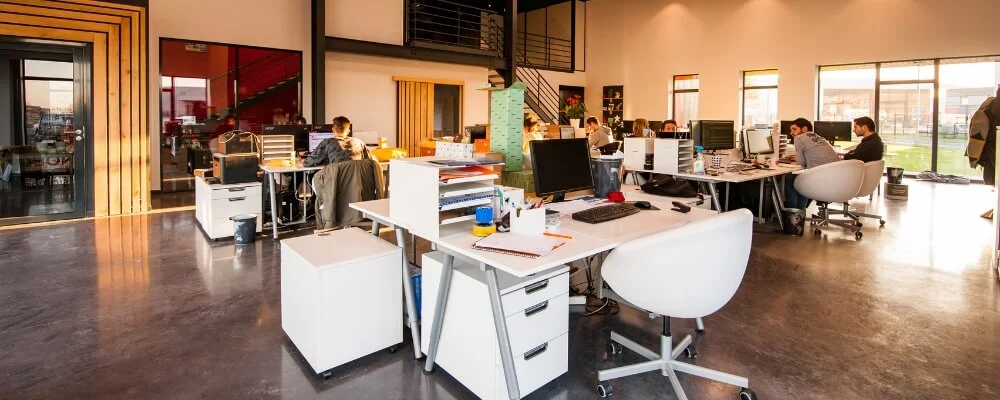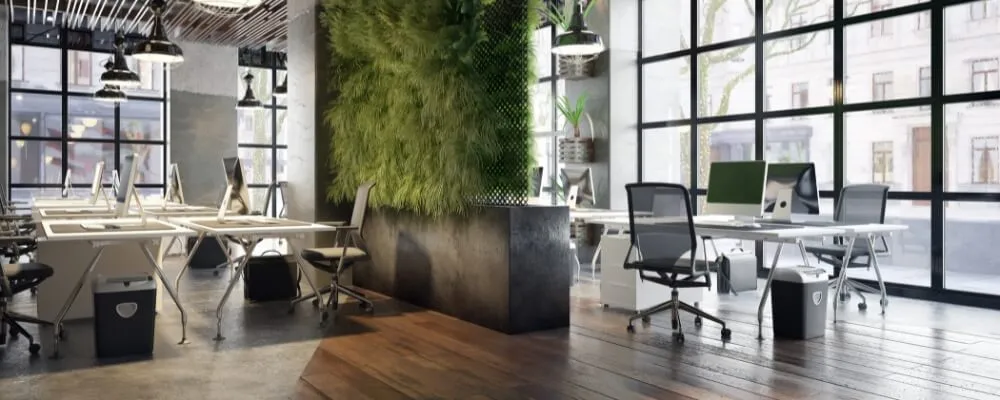The office has become our second home in the hustle and bustle of the modern corporate world. But just like any environment, it’s not devoid of potential hazards. While the risks at a desk job might seem minimal compared to those at a construction site or factory, the importance of safety within the confines of an office cannot be underestimated.
From the innocuous-looking power cable snaking across the floor to the improperly adjusted computer chair, danger lurks in the details. That’s why it’s crucial to be well-informed and proactive. In this blog, we’ll unveil the top 12 office safety tips to ensure that your workplace remains a haven of productivity and safety. Dive in to equip yourself with the knowledge to make your office efficient and a whole lot safer.
Different Hazards In Offices
Office environments might appear low-risk compared to industrial settings, but they still have potential hazards that can harm workers. Here’s a list of common hazards found in office settings:
- Ergonomic Hazards: Poorly designed workstations can lead to a range of musculoskeletal problems. Chairs that don’t provide proper support, keyboards, monitors placed at awkward heights, or even repetitive movements can contribute to injuries over time.
- Tripping and Falling: Loose cables on the floor, open file drawers, cluttered walkways, or wet floors can cause employees to trip or fall.
- Electrical Hazards: Overloaded power outlets, faulty wiring, or malfunctioning office equipment can pose risks of electrical shocks or fires.
- Poor Lighting: Insufficient or harsh lighting can strain eyes and lead to vision problems or headaches. It can also increase the risk of accidents as employees might not see potential hazards.
- Fire Hazards: Accumulating combustible materials like paper, faulty electrical equipment, or unattended kitchen appliances can increase the risk of fires.
- Indoor Air Quality: Poor ventilation, mold, and mildew can compromise indoor air quality. This can lead to respiratory problems or allergic reactions in some employees.
- Chemical Hazards: Offices might house cleaning supplies, printer inks, or other chemicals that can be hazardous if inhaled, ingested, or come into contact with the skin.
- Noise: While offices are usually quieter than industrial settings, they can still have problematic noise levels. The constant ringing of phones, office equipment, and even chatter can be disruptive and cause stress.
- Physical Security: Unauthorized access can threaten the safety of employees and office assets.
- Biological Hazards: In light of global pandemics, offices can become breeding grounds for viruses if proper hygiene and distancing measures are not in place.
- Eye Strain: Prolonged computer use without breaks or using screens with glare and reflection can lead to digital eye strain.
- Manual Handling: Lifting heavy objects like boxes of paper or moving office equipment without proper technique can lead to back or muscle injuries.
- Psychosocial Hazards: Stress, harassment, work-life balance issues, or interpersonal conflicts can be significant concerns in office environments. They might not lead to immediate physical harm, but they can affect mental health and overall well-being over time.
Recognizing and addressing these hazards is essential to create a safe and healthy office environment. Regular risk assessments and safety training can go a long way in minimizing these risks.

Office Safety Tips For A Safer Workplace
While seemingly a benign environment, the modern office is not devoid of potential hazards. Ensuring safety is pivotal not only to protect the well-being of employees but also to bolster productivity and foster a positive work culture. A few simple yet effective measures can transform an office into a sanctuary of safety and efficiency. Here are some essential office safety tips to ensure a safer workplace:
1. Ergonomic Workstations
Ergonomics focuses on designing workspaces to fit the individual needs and physicality of the user. When workstations in offices are ergonomically designed, they can significantly reduce the risk of repetitive strain injuries, back pain, and other related discomforts. This involves ensuring that chairs provide proper lumbar support and can be adjusted to height.
Desks should allow users to place their feet flat on the ground, and their arms should rest comfortably without straining the shoulders. Keyboards should be positioned to keep the wrists neutral, and screens need to be set at eye level, so users don’t need to tilt their heads up or down, which can cause neck strain.
2. Regular Breaks
Taking short, frequent breaks throughout the workday can significantly benefit office workers. These breaks serve as a means to reduce eye strain, alleviate mental fatigue, and prevent physical stiffness from sitting too long. They can also rejuvenate the mind, improving concentration upon return to work. Employers can foster this habit by introducing apps or software reminders encouraging employees to pause and relax for a few minutes every hour. Designating specific relaxation or stretching areas in the office can also be beneficial.
3. Keep Aisles Clear
Ensuring that walkways and aisles are free from obstructions is crucial for office safety. A clear path reduces the chances of employees tripping or falling and getting injured. Moreover, in emergencies, such as fires, clear aisles ensure that evacuation is swift and without hindrance. Regular inspections should be carried out to identify and remove any potential obstructions to maintain clear aisles. Proper storage solutions should be provided, and employees should be educated on the importance of not leaving items in pathways.
4. Tidy Workspaces
A neat and organized workspace offers multiple advantages, from minimizing distractions to promoting efficiency. Cluttered desks can become sources of stress, and scattered items can increase the risk of minor accidents, such as knocking over a cup of coffee. Employers should encourage a “clean-as-you-go” mentality among employees.
Providing adequate storage facilities like drawers and shelves can assist in keeping the workspace tidy. Regularly designated cleanup times, perhaps at the end of each week, can also ensure that workspaces remain orderly and conducive to productivity.
5. Proper Lighting
Good lighting is paramount in an office environment. In fact, proper lighting ergonomics plays a vital role in preventing eye strain, enhancing comfort, and supporting overall visual health by ensuring that tasks, documents, and screens are well-lit without harsh glare. Inadequate lighting can lead to headaches, fatigue, and decreased productivity.
Moreover, shadows or dimly lit areas can also conceal hazards or make them less obvious, increasing the risk of accidents. It’s essential to evaluate the office’s natural and artificial lighting sources. Supplementary lighting, like task lights, can be introduced to enhance visibility and ensure that all work areas, especially desks and pathways, are sufficiently illuminated.

6. Avoid Overloading Electrical Outlets
Overloading an electrical outlet is a common but dangerous mistake. Plugging too many devices into a single outlet can draw more power than the outlet can handle, leading to overheating and possibly causing an electrical fire. This poses not only a risk to equipment but also to the safety of employees.
It’s crucial to understand the capacity of each outlet and to distribute the power demand appropriately. If more devices need to be connected, a certified power strip with surge protection is advisable. Regular inspections should be carried out to ensure that outlets are not overloaded and that cords are in good condition without any exposed wiring.
7. Safe Storage
How items are stored in an office can significantly impact safety. Storing heavy items on lower shelves ensures that, if they fall, they don’t have the added force of height, reducing the risk of injury. On the other hand, if heavy items are stored higher up, there’s not only the risk of them falling on someone but also when someone tries to lift them down, potentially leading to musculoskeletal problems.
Additionally, stacks of items should be stable; haphazard piling can lead to them toppling over. It’s advisable to use storage solutions like cabinets and shelves designed to handle the weight and ensure that items are organized systematically.
8. Emergency Exits
The importance of clear and accessible emergency exits cannot be overstated. These exits can save lives in a crisis, such as a fire, earthquake, or any situation warranting immediate evacuation. Every office should have clearly marked emergency exits that are easily identifiable, even in low-light conditions.
Regular checks should be conducted to ensure these paths are not obstructed by boxes, equipment, or any other items. Employees should be familiarized with the locations of these exits and the routes to reach them. Drills can be periodically conducted to ensure everyone can evacuate the building promptly and safely.
9. Fire Safety
One of the most fundamental aspects of office safety is being prepared for potential fires. Every office should strategically place smoke detectors to detect smoke or fire at its earliest. Regular maintenance checks are necessary to ensure they’re operational and batteries are replaced as required. Also, fire extinguishers should be readily available and placed at designated points throughout the office. Merely having these tools isn’t enough, though.
Employees should be periodically trained on their locations and proper use. Understanding the type of fire extinguisher (water, CO2, foam, etc.) and its correct application can make the difference between a minor incident and a major catastrophe.

10. Cable Management
As offices become increasingly tech-dependent, the number of cables and cords around workstations has surged. While these cables are essential for operations, they can become a significant tripping hazard if not managed properly. Using cord organizers, clips, or even simple cable ties can ensure that these cords are neatly bundled together and kept out of the way.
Offices should avoid running cords across frequently used walkways or under carpets, where they can easily be overlooked and tripped over. A well-organized cable system promotes safety and contributes to a cleaner and more efficient working space.
11. Proper Training
Every piece of equipment in an office, from the seemingly harmless photocopier to the document shredder, comes with operational guidelines and potential risks. Employees should be adequately trained on safely using all equipment they’re expected to use. This training should cover basic operations, safety precautions, and what to do if the equipment malfunctions. Such proactive measures can prevent equipment-related injuries and ensure that devices are used to prolong their lifespan.
12. Emergency Drills
The true test of an office’s emergency preparedness isn’t when everything is running smoothly but how efficiently and safely everyone can respond when things go wrong. Regularly conducted emergency drills help familiarize employees with evacuation routes, safe zones, and protocols, reducing chaos and panic during emergencies. Whether it’s a fire, an earthquake, or another threat, these drills ensure that each individual knows their role and actions. Feedback should be collected after each drill to identify potential bottlenecks or improvement areas, ensuring the response becomes more refined with each practice.
Conclusion
In conclusion, a safe office is not just about ticking off compliance checklists or adhering to regulations. It’s about creating an environment where employees can perform at their best without the looming shadow of potential hazards. By implementing the top 12 office safety tips we’ve outlined, organizations can foster a culture that prioritizes the well-being of its workforce. Remember, a safer workplace is more than just an obligation—it’s a testament to the value an organization places on its most precious asset: its people. As you stride forward in your professional journey, carry these insights with you, ensuring that safety and productivity go hand in hand in your workspace.

